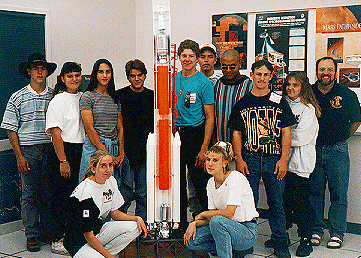by The 1994-1995 Physics Class, Tombstone High School, Tombstone, Arizona
This project was begun on August 23, 1994, when Mr. Wood informed his physics class of the contest that ASU is holding.
The class unanimously voted to enter the contest, and plans for construction were immediately begun. The class then decided to build both a display model of the Delta II and an actual working model. The display model was to be constructed from household materials as the contest rules dictated. The working model would be built from materials ordered from the Estes Model Rocket Company.
Our first step we took was to scale and design a model made from paper. This gave us an idea of the size of the rocket and gave us a chance to work with its dimensions. A paper model of the satellite was also constructed.
Once the paper model was finished, we moved on toward building the actual display model. We divided the class into several groups. The gantry crew included David Wilson, Tia Sharp, Joey Stephany, Brandan Barrios, and Erin Marshall. Gordon Molina and Karl Wendt were the wood shop crew. The booster rocket crew consisted of Crystal Clark, Lily Mohler, Nolana Nerhan, Amy Goodnough, and Peter Bidegain. Mike Witte, Jeremy Giles, and Crystal Clark were on the fairing crew. The model rocket crew included John Torre, Tia Sharp, Susan Langley, Josh St. Germain, and Nolana Nerhan.
The gantry crew set to work constructing the gantry. They made the gantry by first drawing it on large sheets of paper, and then cutting and pinning strips of pine on top of the drawings. These pieces were then glued together and removed from the paper, painted, and the gantry was finished.
Crystal Clark designed the templates for both the booster rockets and the model rocket, and gave the design to the wood shop crew to make. The templates were made from plywood. Once they were made, the booster rocket crew glued the templates together with strips of pine, and sanded the finished cylinder skeletons.
Lily Mohler cut out styrofoam circles and glued them together, and then she and Crystal Clark sanded them down to make the booster nosecones and gimbles. The nosecones were then spray painted and the gimbles were covered with Monokote(TM).
The booster rocket crew melted Monokote onto the booster cylinders with an iron and a blow dryer, which shrunk the Monokote onto the pine strips.
The model rocket was completed in the same way by the model rocket crew. The fairing crew made the fairings and the nosecones in the same way.
The insides of the model rocket were constructed from postage mailing tubes, Monokote, and styrofoam. All of the crews worked together to finish the insides, while the wood shop crew made a display stand from wood.
Our class greatly appreciated the opportunity to work in engineering relating to space exploration. Usually only university students have these opportunities, and the knowledge we have gained from the experience is valuable.

Photos by Brett McClellan, 1 December 1994.